《Komorebi : Memories of the Cambrian Period》
木漏れ日はカンブリア紀の追憶
Mokuhanga (Woodblock Printing), 2021–
なぜヒトは木漏れ日をみると心地よく感じるのだろうか?
以前より心地よさに関する研究として「1/f ゆらぎ」が有名ですが、わたしはそれにもう1つの視点を加えたいとおもい本作を制作しました。
恐竜が誕生するよりも遥か前の古生代(5億7500万~2億5000万年前)。われわれヒトの祖先を含むすべての生き物は、まだ海の中に存在していました。この古生代初期のカンブリア紀は「カンブリア爆発」という言葉で知られているとおり、今日に見られる動物の門のほとんどが一気に出現した時期です。
なぜこのカンブリア紀に生命の数多くが誕生したのか。
その一説にはカンブリア紀に、はじめて生命に“眼が生まれ”、それが生命の爆発的な数の誕生と進化の起爆剤となったからともいわれています(光スイッチ説)。
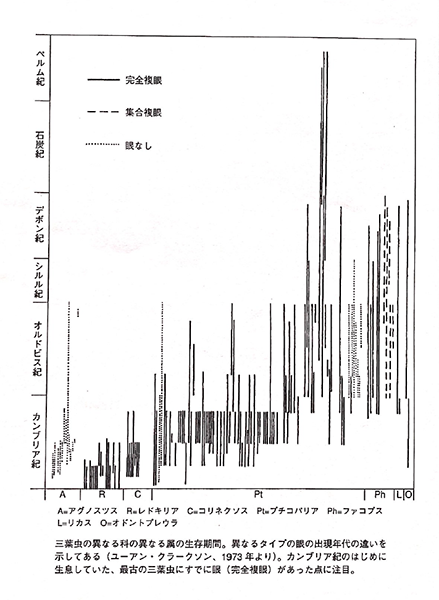
ユーアン・クラークソンによる三葉虫の眼の出現年代。アンドリュー・パーカー『眼の誕生ーーカンブリア紀大進化の謎を解く』p281
カンブリア紀の生物の視力が光を感知する程度のものであったのか、それとも色彩やフォルムまでも精緻に知覚するまでであったかまでは検証されていないものの、イギリスのバイオミメティクス分野の動物学者アンドリュー・パーカー(Andrew Parker, 1967年-)によると、聴覚や嗅覚など他の刺激受容器の緩やかな進化とは異なり、カンブリア紀を境に「見えない」状態から「見える」状態への一足飛びの飛躍した可能性が高いようです。
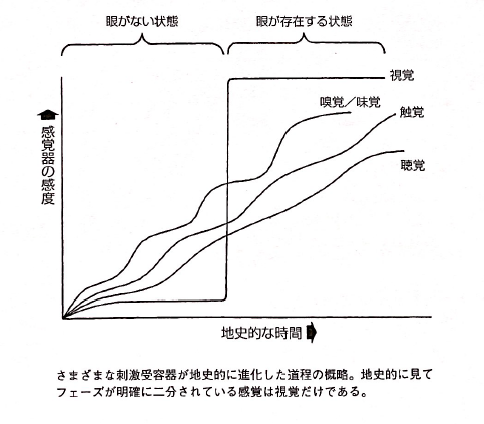
ほかの感覚器と比べて視覚は一足飛びに進化した可能性が高いとされる説。アンドリュー・パーカー『眼の誕生ーーカンブリア紀大進化の謎を解く』p356
またこの頃の海は現在と同じような透明度の高い海水であったとされる説が有力であり、もしそれらが確かであるとするならば、我々の祖先たちは波の合間から差し込む陽の光、そして揺れる波が海底に描き出す光と陰の集光紋様(caustics)の光景を目にしていたに違いありません。

カンブリア時代に眼を獲得した動物が見ていたであろう映像イメージ。アンドリュー・パーカー『眼の誕生ーーカンブリア紀大進化の謎を解く』p340-341より
そこでわたしの自説、「現代のヒトが木漏れ日をみて心地よく感じるのは、生命が眼を獲得したカンブリア紀に海の中で見ていた光景と木漏れ日が似ているから」の話へと進めたいのですが、はたして遥か5億年も前の記憶を我々ヒトはおぼえているものなのでしょうか。
日本の解剖学者・発生学者の三木成夫は、海の中で生活していた古生代の卵と新生代の着床卵には類似点があり、ヒトの卵細胞には地球誌的な生命記憶をもっていると述べています。
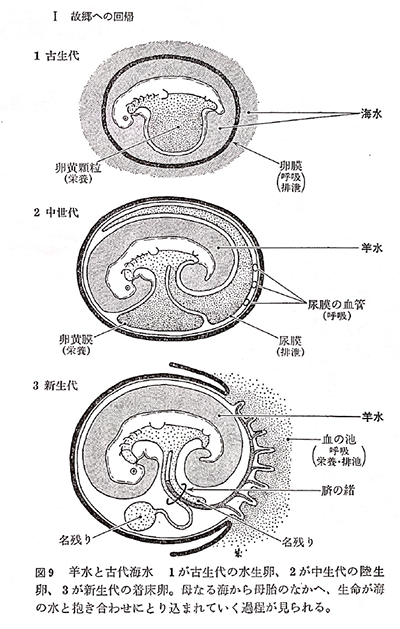
古生代の卵においては海水が入り込んでいたが、新生代の卵においては海水の代わりに羊水がその役割を担っているとする説。三木成夫『胎児の世界』p65
もしDNAという超小型カセットテープに、はじめて眼を獲得したときの光景が原風景のように刻まれているとするならば、その光景に類似する「木漏れ日」を今日に見たときに懐かしさを感じ、親近感をおぼえたとしても不思議ではありません。
| 参考文献: アンドリュー・パーカー『目の誕生ーーカンブリア紀大進化の謎を解く』 草思社, 2006 三木成夫『胎児の世界 人類の生命記憶』中央公論新社, 1983 |
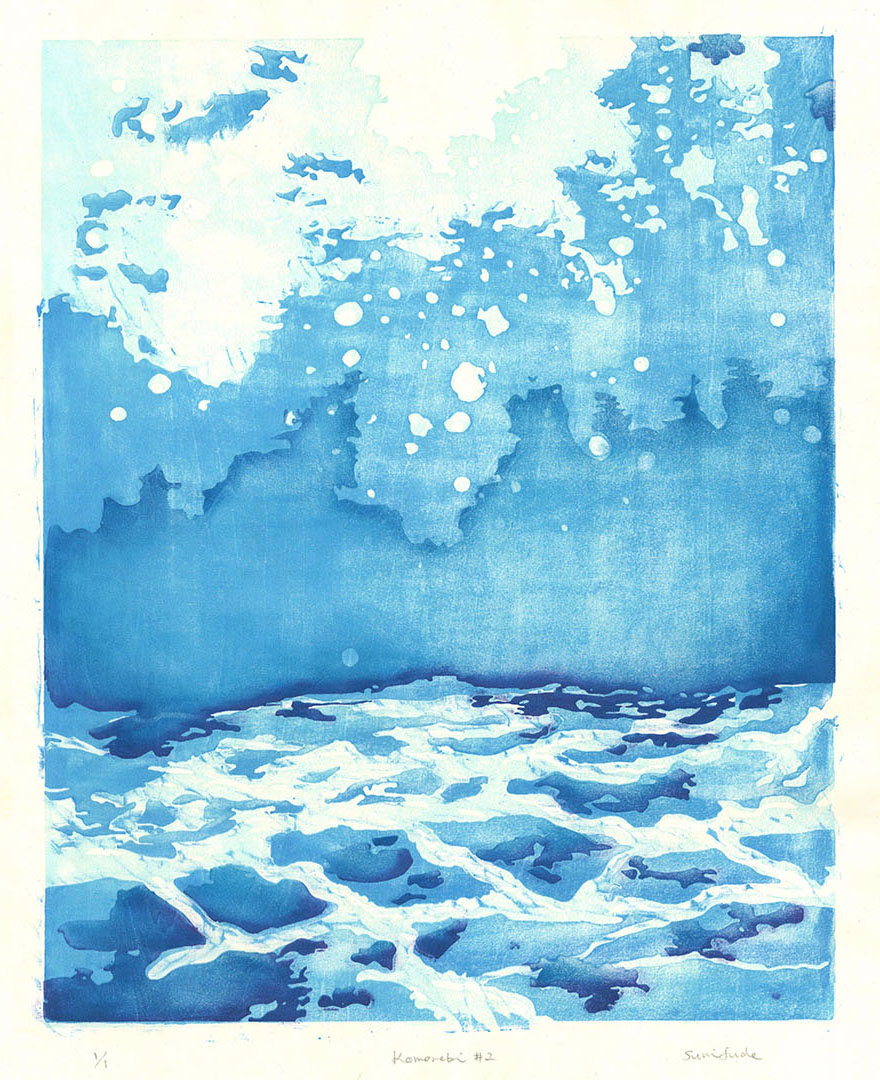
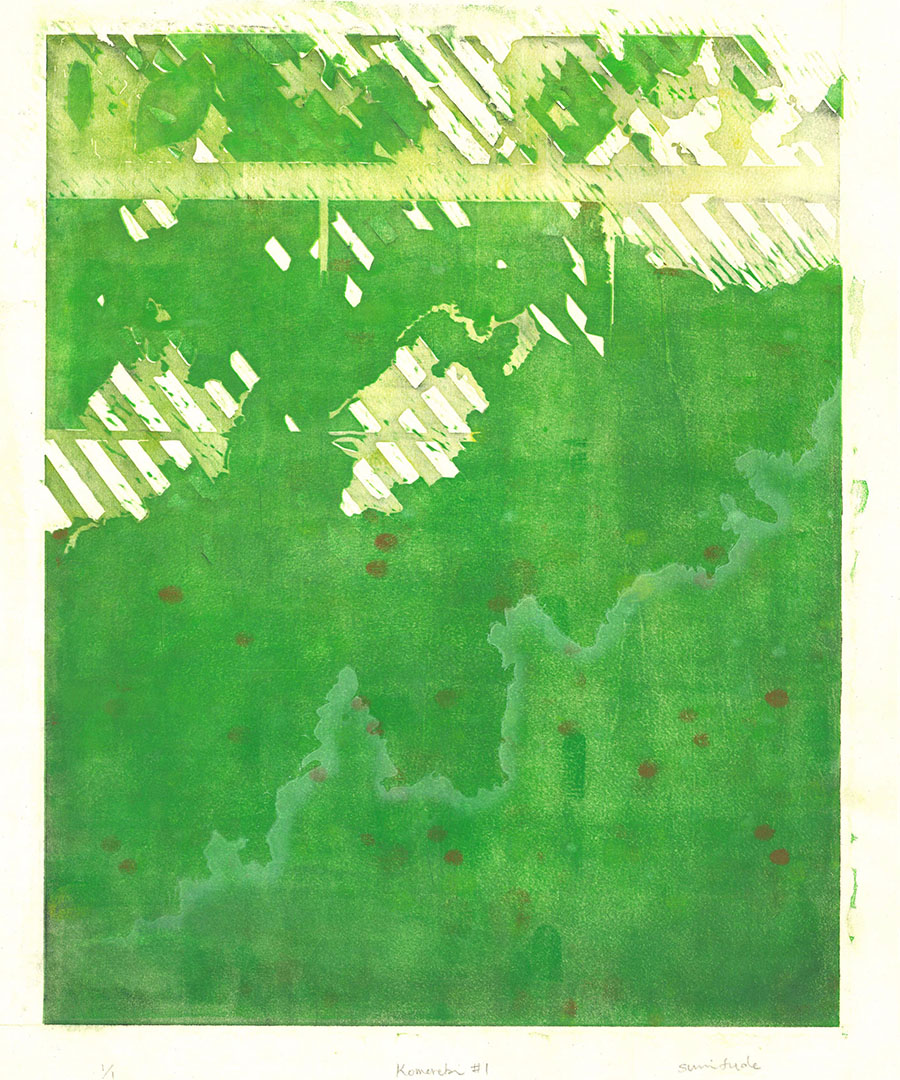
| 日本には浮世絵という多色摺り木版画があり、当時は江戸の街を伝えるブロマイドのような媒体でした。そのため浮世絵を掛軸にして壁に飾るなどはせず、直接手に持って自然光や行灯のあかりで鑑賞していたといわれています。 本作は浮世絵と同様の水性凸版木版画の手法で制作しており、和紙の肌理や風合い、あるいは和紙に写し採られた木版の凹凸なども近くで感じてもらいたいとおもい、額縁にアクリル板は使用せず、マグネット付きの石で四方を留めただけの展示手法にしてあります。 水性木版画, 2021 和紙:初かつお(ひだか和紙) 顔料:ガッシュ彩“いろどり”(ホルベイン) エディション:1/1 紙サイズ:535x420mm イメージサイズ:430x350mm 版数:3 色数:5 摺度数:5 制作年:2021.7 |
▼本作展示のおしらせ
アーツ千代田3331にて上記の新作木版画を展示いたします。
7月31日(土曜)15:00-18:00 在廊します。
会期が3日間と短いですが東京ビエンナーレと抱き合わせで是非お越しください。
開催日時:2021年7月30日(金)〜8月1日(日)
会場:アーツ千代田3331 BF マルチスペースB105
東京都千代田区外神田6-11-145
主催:2021夏の木版画フェア実行委員会「夏のいろどり展」
アクセス アーツ千代田3331 >>
https://www.3331.jp/access/
マルチスペースB105の場所>> *階段あるいはEV降りて左手すぐ
https://www.3331.jp/floor/b105.html
出展者:湯浅克俊、濵田路子、Mariko Jesse、増田昌弘、土屋未沙、Terry McKenna、森田薫、Mia O、井関洋、海老原和雄、河村勇、リュウロヨ、SUMIFUDE、磯上尚江、Ni Mingxia、本田このみ、古知屋恵子
---EN---
Why do we feel comfortable when we see 'Komorebi ' the sunlight filters through the trees? The "1/f fluctuation" has been famous research on comfort for a long time, but I wanted to add another perspective to it, so I created this work.
The Paleozoic Era (575 to 250 million years ago), long before the birth of the dinosaurs. In the Paleozoic era, all living things, including our ancestors, still existed in the sea. The Cambrian period in the early Paleozoic era is known as the "Cambrian Explosion," when most of the animal phyla we see today appeared at once.
Why did so many forms of life emerge during the Cambrian period? One theory is that the Cambrian period was the first time life had eyes and that this was the catalyst for the explosion of life and its evolution ('The Light-Switch Hypothesis').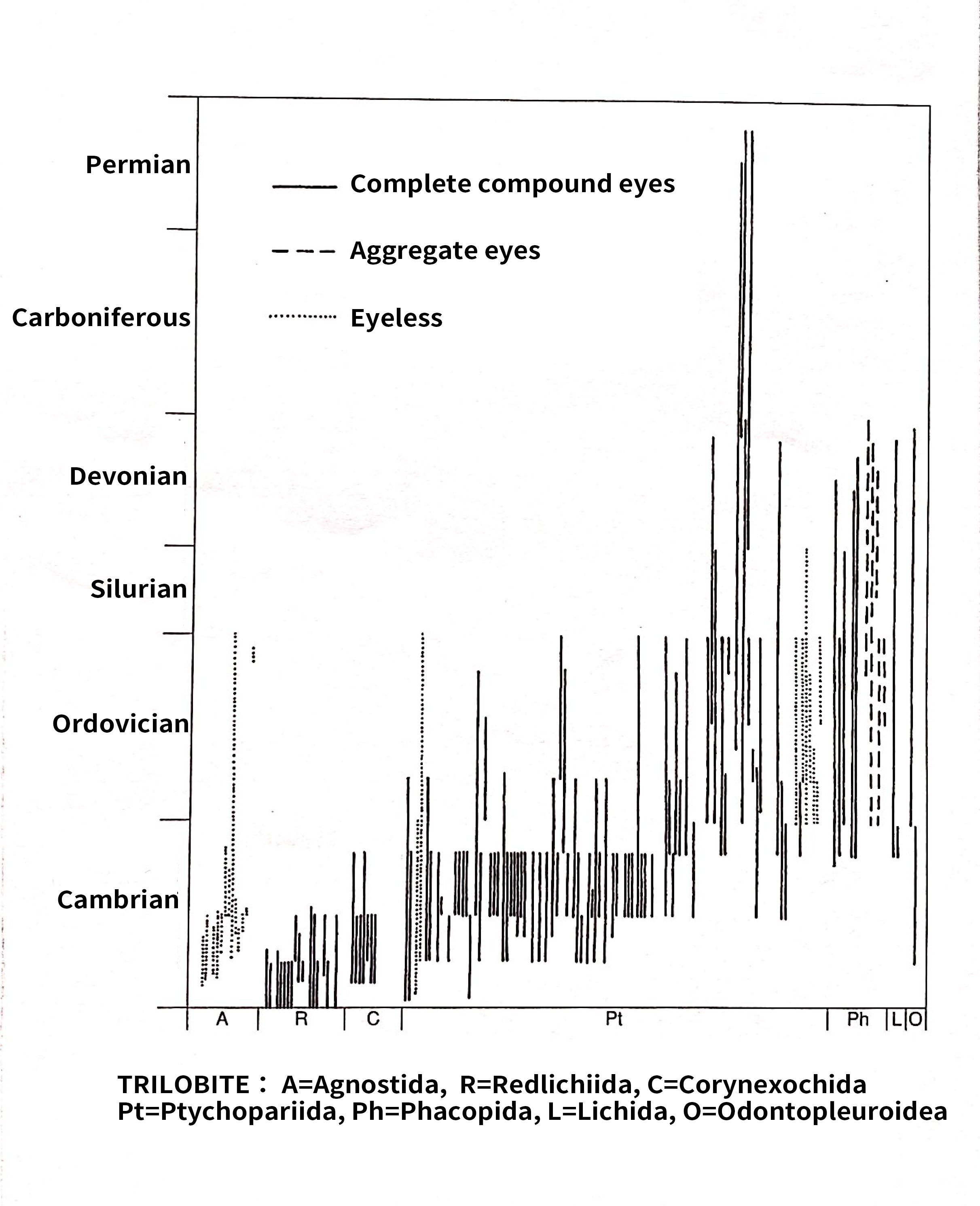
Date of appearance of the trilobite eye by Euan Clarkson. Andrew Parker,眼の誕生ーーカンブリア紀大進化の謎を解く,p281
According to Andrew PARKER, a British zoologist in the field of biomimetics, unlike the gradual evolution of other stimulus receptors such as hearing and smell, there is a strong possibility that we made a quantum leap from "invisible" to "visible" after the Cambrian period.
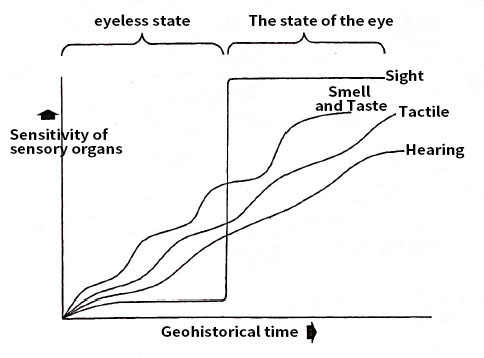
Compared to other sensory organs, vision is likely to have evolved in a single step. Andrew Parker,眼の誕生ーーカンブリア紀大進化の謎を解く, p356
If these theories are true, then our ancestors must have seen the sunlight coming in between the waves, and the caustics of light and shade that the swaying waves created on the seafloor.

An image of what an animal that acquired eyes in the Cambrian era would have seen. Andrew Parker,眼の誕生ーーカンブリア紀大進化の謎を解く, p340-341
I would like to move on to my pet theory that the reason why people today feel comfortable when they see the sun shining through the trees is that 'Komorebi ' is similar to what we saw in the sea during the Cambrian period when life acquired eyes.
According to the Japanese anatomist and embryologist MIKI Shigeo, there are similarities between the Paleozoic egg that lived in the sea and the implanted egg of the Cenozoic era, and he states that human egg cells have an earth-historical life memory.

In the Paleozoic era, seawater entered the egg, but in the Cenozoic era, amniotic fluid plays a role instead of seawater. Shigeo Miki,胎児の世界, p65
If the ultra-small cassette tape called DNA has the scene of when we first acquired our eyes engraved on it like an original landscape, it is no wonder that we feel nostalgia and familiarity when we see 'Komorebi ' . -Translated with DeepL
| References: Andrew PARKER『目の誕生ーーカンブリア紀大進化の謎を解く』 草思社, 2006 MIKI Shigeo『胎児の世界 人類の生命記憶』中央公論新社, 1983 Komorebi: -This is the word the Japanese have for when sunlight filters through the trees ‒ the interplay between the light and the leaves. ― Ella Frances Sanders, 11 Untranslatable Words From Other Cultures -This word refers to the sunlight shining through the leaves of trees, creating a sort of dance between the light and the leaves. ― OxfordBlog, 15 Japanese words that English needs |


| Mokuhanga, Water-based woodblock printing, 2021 Hatsu Katsuo, HIDAKA-WASHI Gouache“IRODORI”, Holbein edition: 1/1 paper size: 535x420mm image size: 430x350mm number of blocks: 3 number of colors: 5 number of passes: 5 Year Completed: 2021 July |